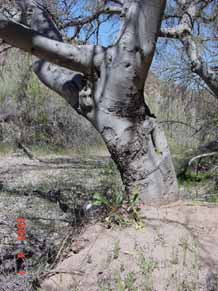
Netleaf Hackberry (Celtis reticulata)
Main sources: Petrides, George & Olivia Petrides, 1992, A Field Guide to Western Trees, pp. , Houghton-Mifflin; Zimmerman, Robert, 1969, Plant Ecology of an Arid Basin Tres Alamos-Redington Area Southeastern Arizona, Geological Survey Professional Paper 485-D, Washington, D.C.; Epple, Ann, 1995, A Field Guide to the Plants of Arizona p. 47, Helena, Montana: Fountain Press; see also the USDA Forest Service Database.
Hackberry trees (Elm family) grow from northern Mexico to the Pacific Northwest, and because they readily hybridize their classification is confused. All western Hackberries tend to have triangular, long-pointed, uneven-based, short-stalked, and often sandpaper-textured leaves which usually lack serration. The Netleaf species, in contrast to its sister the Desert Hackberry, is deciduous, its leaves first turning yellow in the Fall (see below). It also has leaves that are wide (about half the leaf length) and when mature, somewhat leathery, and strongly net-veined ("reticulated") beneath. Here, below left , is an upperside view of some young leaves, while below right you see a view through an old leaf, showing the networking more clearly:
(Click on each image to enlarge it.)
While it may occasionally appear as a shrub in unfavorable locations, Netleaf Hackberry trees may grow quite tall (to 50 feet and as much as 2 feet in diameter) in the floors of our larger desert washes, and along the San Pedro River especially where it has perennial flow north of the confluence of Hot Springs Canyon Wash. (They are often found in association with our other riparian trees.) In our general area it grows at elevations as high as 6,000 feet, mostly in moist soils, streams, but sometimes also on hillsides in upper desert and oak woodlands. The bark is characteristically gray, with dark fissures and warty knobs and ridges in the older trees (see further below). Twigs are slender and often form twisting networks. Roots are strongly tap-rooted but wide-spreading as well.
Below left, a substantial Netleaf Hackberry growing in the vertical cracks of a Willow Canyon Formation cliffside in lower Sierra Blanca Canyon Wash. This image shows some of the "twisting networks" of its canopy (and see also the banner photo at the top of this page), while the one below right shows a tree trunk that appears to have grown up largely inside a particular vertical crack in loosely-consolidated slabs of rock, gradually becoming more exposed as rock surfaces have flaked off. (Click on each image to enlarge it.)
 Inconspicuous, greenish flowers (see the photo at left) develop into small, round, red-to-brownish, one-seeded fruits that remain smooth when dry. The fruits are covered by a thin but sweet edible layer. (Click on the image to enlarge it.)
Inconspicuous, greenish flowers (see the photo at left) develop into small, round, red-to-brownish, one-seeded fruits that remain smooth when dry. The fruits are covered by a thin but sweet edible layer. (Click on the image to enlarge it.)
The leaves are browsed by deer and the fruits are eaten by many kinds of birds and mammals. (Many Native American peoples harvested the fruit as well.) Because the tree's canopy tends to become quite dense (as you can see from the banner image above, top), large mammals often favor it for cover, and many kinds of birds use it for nesting and resting sites.
Mature Netleaf trunks show a very gnarled grayish bark, below:(Click on the images to enlarge)
Below, autumn leaves in November. These will fall by January, leaving the tree bare.
(Click on the image to enlarge it.)
For more detailed images, Click here.
 .....
.....




